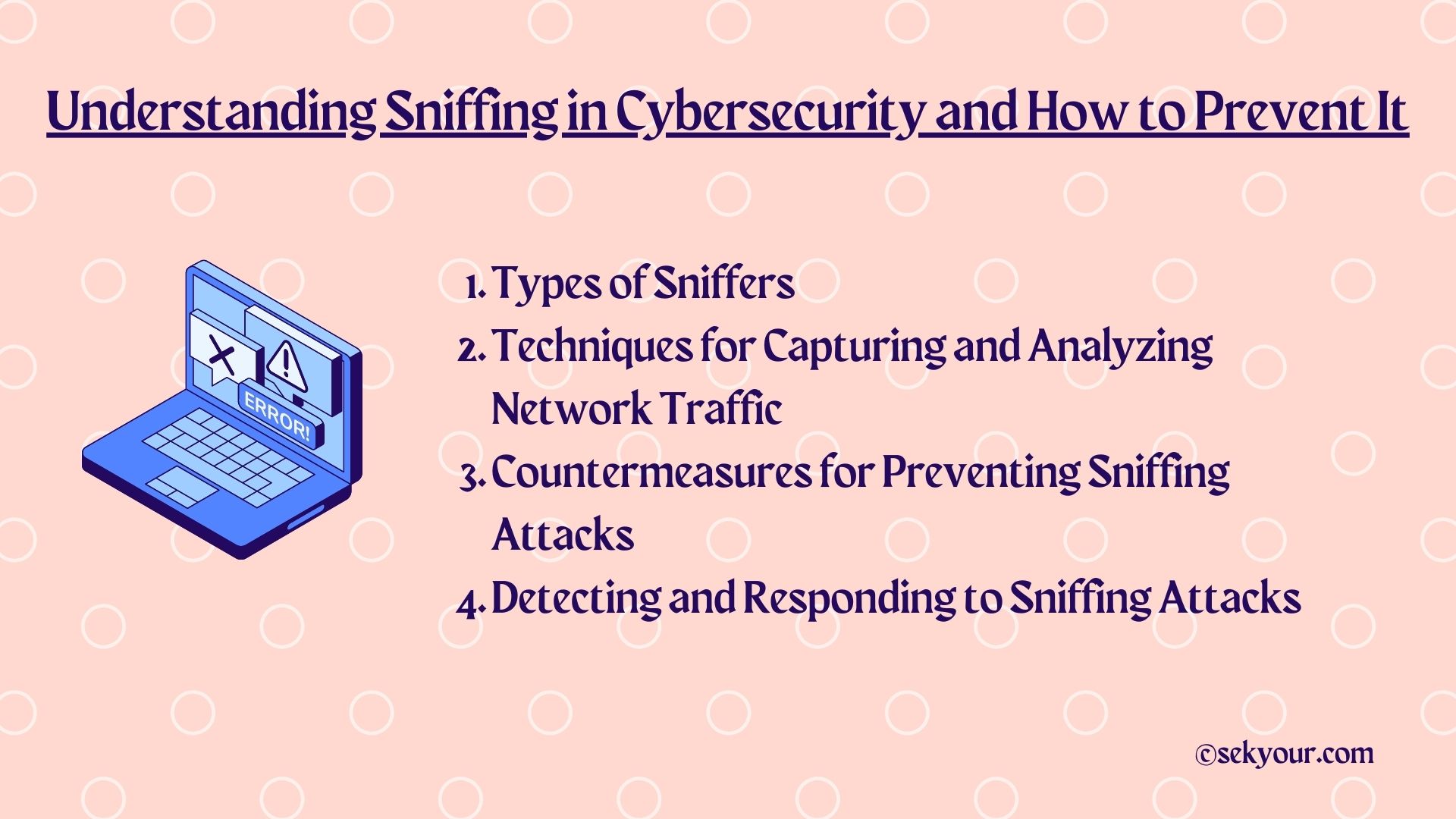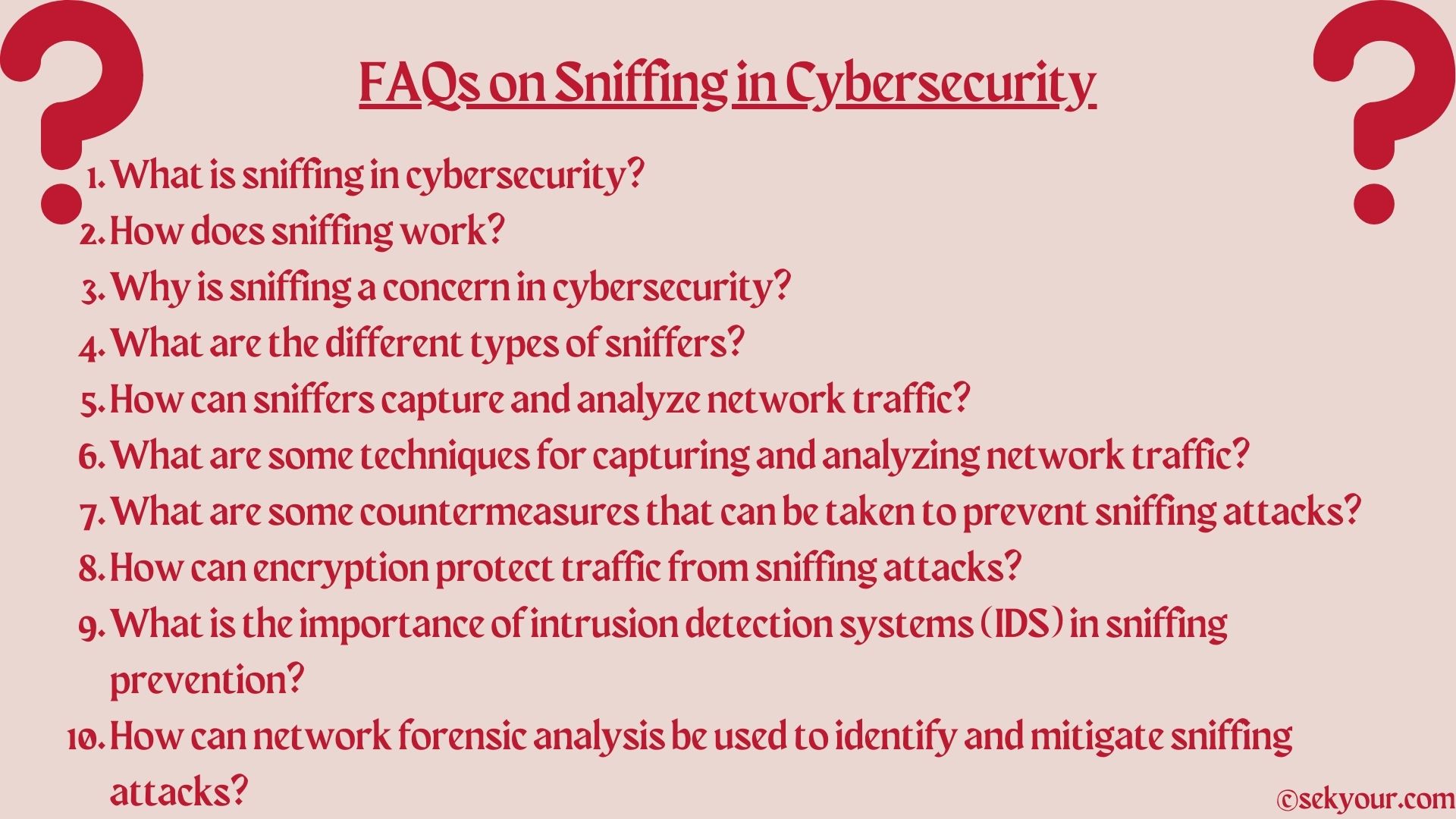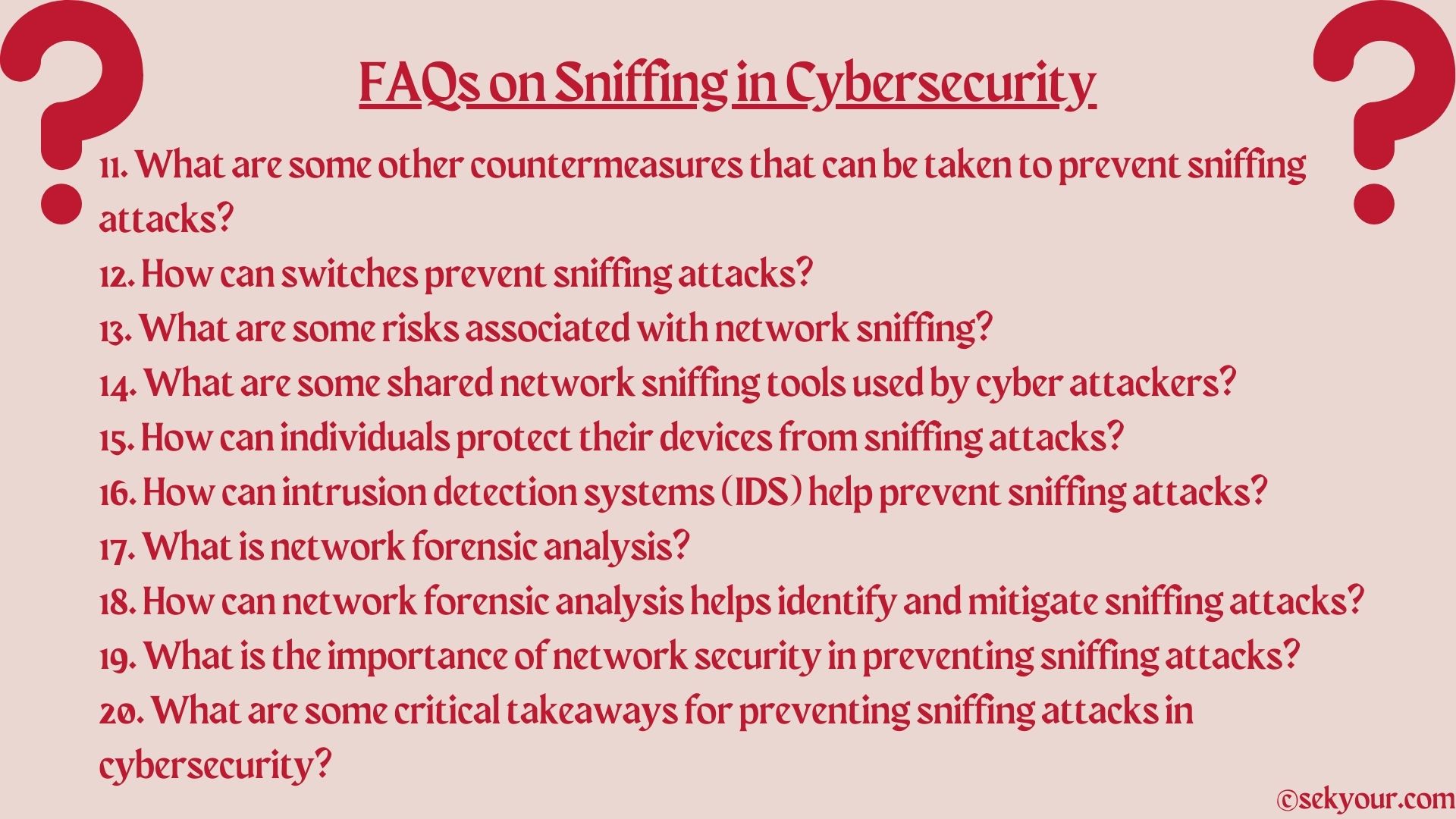1. Introduction
In today’s interconnected digital world, network security is of utmost importance. One of the significant concerns in cybersecurity is network sniffing. Sniffing is capturing and analyzing network traffic to obtain information or identify vulnerabilities. It is a common technique used by attackers to compromise network security. Once an attacker has gained access to a network, they can use sniffing to intercept confidential data and sensitive information, putting the entire system at risk.
The potential damage caused by sniffing attacks is immense. Attackers can quickly gain access to passwords, credit card details, and other sensitive information that can be used to compromise the network. Therefore, taking preventive measures to protect the network from sniffing attacks is crucial.
In the following sections, we will discuss the types of sniffers, techniques for capturing and analyzing network traffic, countermeasures for preventing sniffing attacks, and detecting and responding to sniffing attacks. By implementing these measures, we can enhance network security and protect against the risks of sniffing attacks.

2. Types of Sniffers
Two main types of sniffers are commonly used to capture and analyze network traffic in cybersecurity: protocol and packet.
Protocol sniffers are designed to capture and analyze traffic at the network layer. They work by monitoring traffic flowing through the network and extracting data specific to a particular protocol. This makes them useful for troubleshooting issues related to network protocols, such as TCP/IP.
On the other hand, packet sniffers are designed to capture and analyze traffic at the data link layer. They work by capturing data packets that are transmitted across the network and analyzing their contents. This makes them useful for monitoring and analyzing network traffic content, including data sent between applications.
The critical difference between these two types of sniffers is the OSI model layer they operate on. Protocol sniffers operate on the network layer, while packet sniffers operate on the data link layer.
In addition to these two main types of sniffers, several advanced sniffing techniques are commonly used in cybersecurity. For example, some attackers use man-in-the-middle (MITM) attacks to intercept and modify network traffic. Others use sniffing tools to capture and analyze encrypted traffic, which can be challenging to detect and prevent.
Overall, it is essential to understand the differences between the various types of sniffers and to be aware of the advanced techniques that attackers use to compromise network security. By implementing effective countermeasures, we can minimize the risk of sniffing attacks and enhance the security of our networks.
3. Techniques for Capturing and Analyzing Network Traffic
Capturing and analyzing network traffic is a critical aspect of network security. Several different techniques can be used to capture and analyze network traffic, each with its strengths and weaknesses.
One of the most common techniques for capturing and analyzing network traffic is packet sniffing. Packet sniffers are software tools that can be used to capture and analyze the content of data packets that are transmitted over a network. These tools are handy for monitoring and analyzing traffic between applications.
Another essential technique for capturing and analyzing network traffic is traffic sniffing. Traffic sniffers are tools that can be used to capture and analyze traffic at the network layer. They work by monitoring traffic on the network and extracting data specific to a particular protocol. This makes them helpful in identifying potential security threats and troubleshooting network issues.
It is important to use filters, decoders, and analyzers to make the most of these techniques. Filters can be used to specify the type of traffic that should be captured, while decoders can be used to decode captured traffic into a human-readable format. Analyzers can then be used to analyze captured traffic for patterns and anomalies, helping to identify potential security threats.
There are several different examples of tools that can be used to capture and analyze network traffic. Examples include Wireshark, tcpdump, and Microsoft Network Monitor.
Preventing traffic sniffing attacks is another crucial aspect of network security. One effective way to avoid traffic sniffing attacks is to use encryption to protect the traffic. Other measures include using switches instead of hubs and virtual LANs (VLANs) to segment network traffic.
Understanding the different techniques for capturing and analyzing network traffic is critical to maintaining network security. Using the appropriate tools and implementing effective countermeasures can minimize the risk of security threats and protect our networks against sniffing attacks.
4. Countermeasures for Preventing Sniffing Attacks
Sniffing attacks pose a significant threat to network security. However, several countermeasures can be taken to prevent these attacks and minimize the risk of security breaches.
One effective way to prevent sniffing attacks is to use encryption to protect network traffic. Encryption involves encoding data so that it is only readable by authorized parties. This can help to prevent unauthorized individuals from intercepting and analyzing network traffic.
Another effective countermeasure is to use switches instead of hubs. Hubs broadcast all incoming traffic to all connected devices, making it easy for attackers to intercept and analyze network traffic. Switches, conversely, only send traffic to the intended recipient, making it much more difficult for attackers to intercept and analyze network traffic.
Virtual LANs (VLANs) are another effective countermeasure for preventing sniffing attacks. VLANs segment network traffic, grouping devices that have similar communication needs. This can help prevent attackers from intercepting and analyzing network traffic by making accessing sensitive information more difficult.
In addition to these measures, several other countermeasures can be taken to prevent sniffing attacks. For example, using strong passwords and implementing user authentication measures can help prevent unauthorized network access. Implementing firewalls and intrusion detection systems can also help detect and avoid sniffing attacks.
Knowing the vulnerabilities and exploits commonly used in sniffing attacks is also essential. The most common vulnerabilities include unsecured Wi-Fi networks, unsecured remote access points, and unsecured network servers. We can significantly reduce the risk of security breaches by addressing these vulnerabilities and implementing appropriate countermeasures.
In conclusion, preventing sniffing attacks is critical to maintaining network security. By implementing the appropriate countermeasures, such as using encryption, switches, and VLANs, and addressing common vulnerabilities, we can minimize the risk of security threats and protect our networks against sniffing attacks.
5. Detecting and Responding to Sniffing Attacks
Despite our best efforts, it is only sometimes possible to prevent sniffing attacks from occurring. When these attacks occur, detecting them quickly and responding appropriately to minimize the damage is essential.
One of the most effective ways to detect sniffing attacks is to use intrusion detection systems (IDS). IDS can be configured to monitor network traffic for suspicious behavior, such as unusual traffic patterns or attempts to access restricted resources. When suspicious activity is detected, the IDS can trigger alerts or take other actions to mitigate the threat.
In addition to IDS, network forensic analysis can also be used to identify and respond to sniffing attacks. This involves analyzing network traffic logs and other relevant data to identify the attack’s source and the damage’s extent. This can help determine the attacker and take appropriate actions to prevent similar attacks.
When a sniffing attack is detected, it is essential to respond quickly and effectively to minimize the damage. This may involve shutting down the affected network or segmenting the network to prevent further damage. Identifying and removing compromised devices, such as those with unauthorized sniffing software installed, is also essential.
To detect network sniffing attacks, it is essential to be familiar with the common signs of these attacks, such as a sudden increase in network traffic, unauthorized access to sensitive information, or unusual activity on the network. By monitoring the network for these signs and other suspicious behavior, it is possible to detect sniffing attacks before they cause severe damage.
6. Conclusion
Preventing sniffing attacks is essential for maintaining the security and integrity of our networks. Sniffing attacks can gather sensitive information, identify vulnerabilities, and launch other cyber attacks. By understanding the different types of sniffers, the techniques used for capturing and analyzing network traffic, and the countermeasures that can be taken to prevent these attacks, we can better protect our networks from these threats.
Some of the most effective countermeasures for preventing sniffing attacks include using encryption to protect traffic, switches instead of hubs, and virtual LANs (VLANs) to segment network traffic. Other countermeasures may include limiting physical access to network devices, using intrusion detection systems (IDS), and implementing strong access controls and authentication measures.
In cybersecurity and digital marketing, network sniffing can be used for various purposes, including identifying weaknesses in marketing strategies and campaigns, analyzing customer behavior, and improving overall network security. However, using these techniques responsibly and ethically and taking appropriate measures to protect against sniffing attacks and other cyber threats is essential.
To prevent sniffing attacks, it is crucial to be aware of the risks and vulnerabilities associated with network sniffing and to take proactive steps to protect against these threats. This includes using strong encryption, implementing network segmentation and access controls, and using advanced techniques such as intrusion detection and network forensic analysis.
In conclusion, network sniffing is a powerful tool that can be used for both positive and negative purposes. By understanding the risks and taking appropriate countermeasures, we can leverage the benefits of network sniffing while protecting our networks from the threats posed by this technique.
7. FAQs on Sniffing in Cybersecurity

1. What is sniffing in cybersecurity?
Sniffing is capturing and analyzing network traffic to collect information or identify vulnerabilities. In cybersecurity, it refers to intercepting and analyzing data packets on a network, aiming to steal sensitive information such as passwords or confidential data.
2. How does sniffing work?
A sniffer is a tool or software that captures and analyzes data packets transmitted over a network. These packets can be intercepted in real time, allowing the attacker to obtain sensitive information such as login credentials, personal information, or financial data.
3. Why is sniffing a concern in cybersecurity?
Sniffing is a significant security concern in cybersecurity because it can lead to the theft of sensitive information, data breaches, and loss of business reputation. Once an attacker has access to sensitive data, they can use it for various malicious purposes such as identity theft, financial fraud, or corporate espionage.
4. What are the different types of sniffers?
The two main types of sniffers are protocol sniffers and packet sniffers. Protocol sniffers capture and analyze traffic at the network layer, while packet sniffers capture and analyze traffic at the data link layer. More advanced techniques are also used in sniffing attacks, such as session hijacking and man-in-the-middle attacks.
5. How can sniffers capture and analyze network traffic?
Sniffers can capture network traffic using hardware devices or software tools. Once the data packets are captured, sniffers can analyze them to extract information such as login credentials, email messages, or financial data. Sniffers can also be used to detect vulnerabilities in a network, allowing the attacker to exploit them for malicious purposes.
6. What are some techniques for capturing and analyzing network traffic?
Some techniques for capturing and analyzing network traffic include using filters to specify the type of traffic to capture, decoders to decode captured traffic, and analyzers to analyze captured traffic for patterns and anomalies.
7. What are some countermeasures that can be taken to prevent sniffing attacks?
Some countermeasures that can be taken to prevent sniffing attacks include using encryption to protect traffic, using switches instead of hubs, and using virtual LANs (VLANs) to segment network traffic.
8. How can encryption protect traffic from sniffing attacks?
Encryption can protect traffic from sniffing attacks by encoding the transmitted data, making it unreadable to anyone without the proper decryption key.
9. What is the importance of intrusion detection systems (IDS) in sniffing prevention?
Intrusion detection systems (IDS) are essential in sniffing prevention as they can detect when network traffic is being analyzed or intercepted, allowing for immediate response and mitigation.
10. How can network forensic analysis be used to identify and mitigate sniffing attacks?
Network forensic analysis can identify and mitigate sniffing attacks by analyzing captured traffic to identify the source of the attack and the vulnerabilities that were exploited. This information can then be used to improve security measures and prevent similar attacks in the future.

11. What are some other countermeasures that can be taken to prevent sniffing attacks?
Other countermeasures that can be taken to prevent sniffing attacks include implementing strong access control policies, regularly updating software and hardware, and conducting regular security audits.
12. How can switches prevent sniffing attacks?
Switches can prevent sniffing attacks by only forwarding traffic to the intended recipient rather than broadcasting it to all devices on the network as hubs do.
13. What are some risks associated with network sniffing?
Risks associated with network sniffing include the theft of sensitive information such as passwords and credit card numbers and the ability of attackers to gain access to sensitive systems and data.
14. What are some shared network sniffing tools used by cyber attackers?
Shared network sniffing tools cyber attackers use include Wireshark, tcpdump, and Cain and Abel.
15. How can individuals protect their devices from sniffing attacks?
Individuals can protect their devices from sniffing attacks by using a virtual private network (VPN) to encrypt traffic, using secure passwords and two-factor authentication, and keeping their software and operating systems up-to-date.
16. How can intrusion detection systems (IDS) help prevent sniffing attacks?
Intrusion detection systems (IDS) can help prevent sniffing attacks by continuously monitoring network traffic for suspicious activity and alerting security personnel to potential threats.
17. What is network forensic analysis?
Network forensic analysis investigates and analyzes network activity to identify and mitigate security incidents, including sniffing attacks.
18. How can network forensic analysis help identify and mitigate sniffing attacks?
Network forensic analysis can help identify and mitigate sniffing attacks by examining network traffic patterns and identifying unusual or suspicious activity that may indicate a sniffing attack.
19. What is the importance of network security in preventing sniffing attacks?
Network security is crucial in preventing sniffing attacks, as it involves implementing a range of countermeasures to protect network traffic and systems from potential vulnerabilities and exploits.
20. What are some critical takeaways for preventing sniffing attacks in cybersecurity?
Some key takeaways for preventing sniffing attacks in cybersecurity include using encryption to protect traffic, implementing access control policies, conducting regular security audits, and using intrusion detection systems and network forensic analysis to detect and respond to potential attacks. It is also vital to stay up-to-date on the latest threats and vulnerabilities and to maintain a strong culture of cybersecurity awareness and best practices.